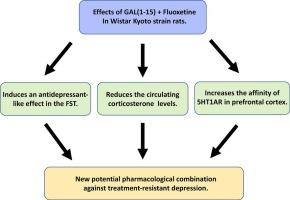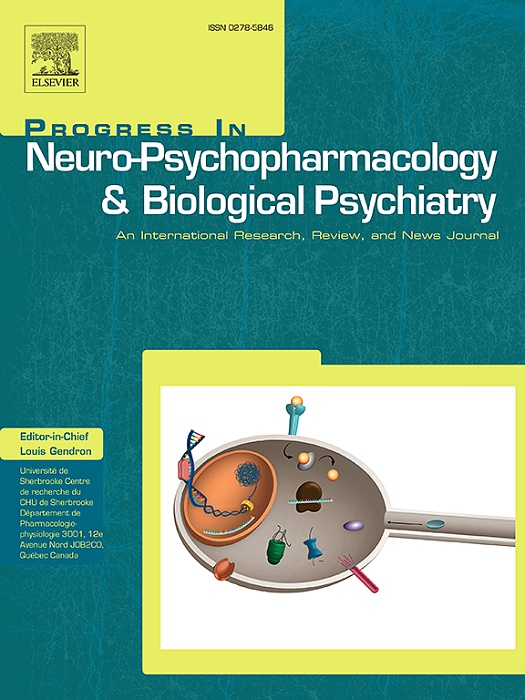针对耐药性抑郁症的新型药物疗法。
IF 5.3
2区 医学
Q1 CLINICAL NEUROLOGY
Progress in Neuro-Psychopharmacology & Biological Psychiatry
Pub Date : 2024-11-08
DOI:10.1016/j.pnpbp.2024.111191
引用次数: 0
摘要
全世界有 5000 多万人患有重度抑郁症。然而,50%的患者对两种或两种以上的药物或心理治疗无效,被称为治疗耐受性抑郁症(TRD)。在这项研究中,我们提出了一种针对 TRD 的新的增强治疗方法,该方法基于氟西汀(FLX)和 N 端片段 Galanin(GAL(1-15))的结合。在 Wistar Kyoto (WKY) 大鼠(在遗传学上类似于内源性抑郁症)中,我们评估了 GAL(1-15) 在绝望和失神测试中对 FLX 诱导行为的影响。我们使用拮抗剂 M871 和 siRNA 5-HT1A 敲除体内模型探讨了 GALR2 的参与情况。此外,我们还通过自显影结合分析了5-HT1AR在多个脑区的情况。我们分析了皮质酮水平和地塞米松抑制的促肾上腺皮质激素释放激素刺激,以研究 HPA 轴的调节。我们的研究结果表明,只有 FLX + GAL(1-15)的组合才能在与绝望有关的行为测试中对 WKY 动物产生抗抑郁作用。这种组合还能降低 WKY 动物体内的皮质酮水平,并调节前额叶皮质中 5-HT1A 血清素能受体的功能特性。这些新结果表明,将GAL(1-15)与FLX结合使用是治疗TRD病例的一种新的增效策略。这表明,加兰宁能系统和血清素能系统之间的相互作用具有创新潜力,可用于寻找治疗抗药性抑郁症的新策略和新药物。本文章由计算机程序翻译,如有差异,请以英文原文为准。

A new pharmacological strategy against treatment-resistant depression
Major depressive disorder affects more than 50 million people in the world. However, 50% of patients don't respond to two or more drugs or psychotherapeutic treatments, named treatment-resistant depression (TRD). In this work, we propose a new augmentation treatment against TRD based on combining Fluoxetine (FLX) and the N-terminal fragment Galanin, GAL(1–15). In Wistar Kyoto (WKY) rats, akin to endogenous depression genetically, we evaluate GAL(1–15)’s impact on FLX-induced behaviours on tests measuring despair and anhedonia. We explored GALR2 involvement using the antagonist M871 and an in vivo model with siRNA 5-HT1A knockdown. Also, the 5-HT1AR was analyzed by autoradiography binding in several brain regions. We analyze the corticosterone levels and a dexamethasone-suppressed corticotropin-releasing hormone stimulation to study the HPA axis regulation. Our results shows that only the combination of FLX + GAL(1–15) induced antidepressant effects in the WKY animals in Behavioural tests related to despair. This combination also reduced corticosterone levels in the WKY animals and modulated the functional characteristics of the serotoninergic receptor 5-HT1A in the prefrontal cortex. These novel results suggest combining GAL(1–15) with FLX is a new potentiation strategy in TRD cases. It shows the innovative potential of the interactions between the galaninergic and serotonergic systems to find new strategies and drugs against resistant depression.
求助全文
通过发布文献求助,成功后即可免费获取论文全文。
去求助
来源期刊
CiteScore
12.00
自引率
1.80%
发文量
153
审稿时长
56 days
期刊介绍:
Progress in Neuro-Psychopharmacology & Biological Psychiatry is an international and multidisciplinary journal which aims to ensure the rapid publication of authoritative reviews and research papers dealing with experimental and clinical aspects of neuro-psychopharmacology and biological psychiatry. Issues of the journal are regularly devoted wholly in or in part to a topical subject.
Progress in Neuro-Psychopharmacology & Biological Psychiatry does not publish work on the actions of biological extracts unless the pharmacological active molecular substrate and/or specific receptor binding properties of the extract compounds are elucidated.

 求助内容:
求助内容: 应助结果提醒方式:
应助结果提醒方式:


